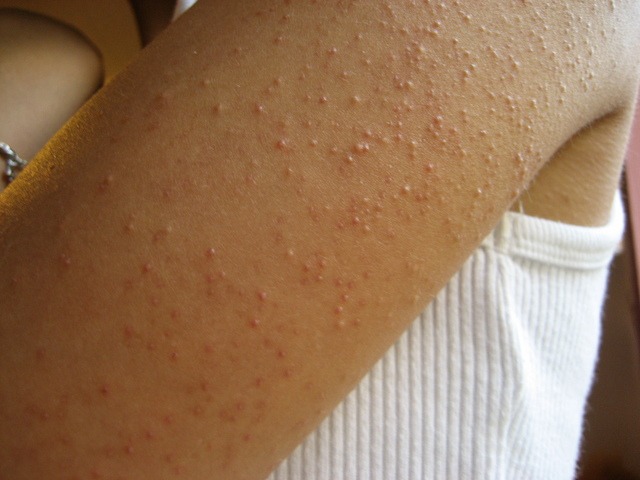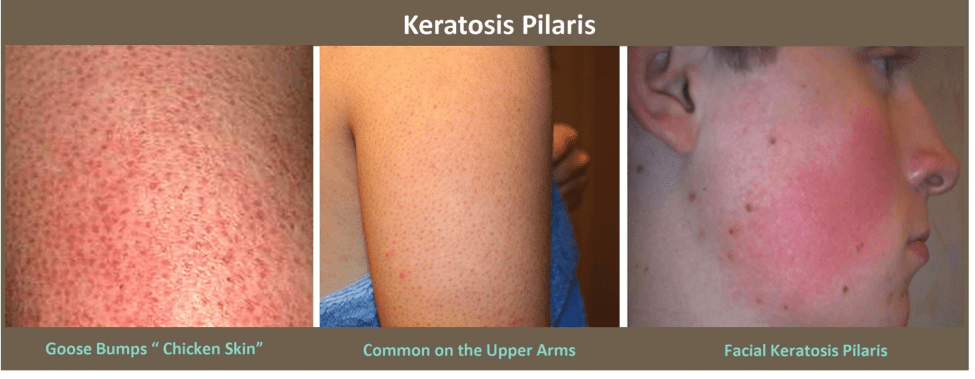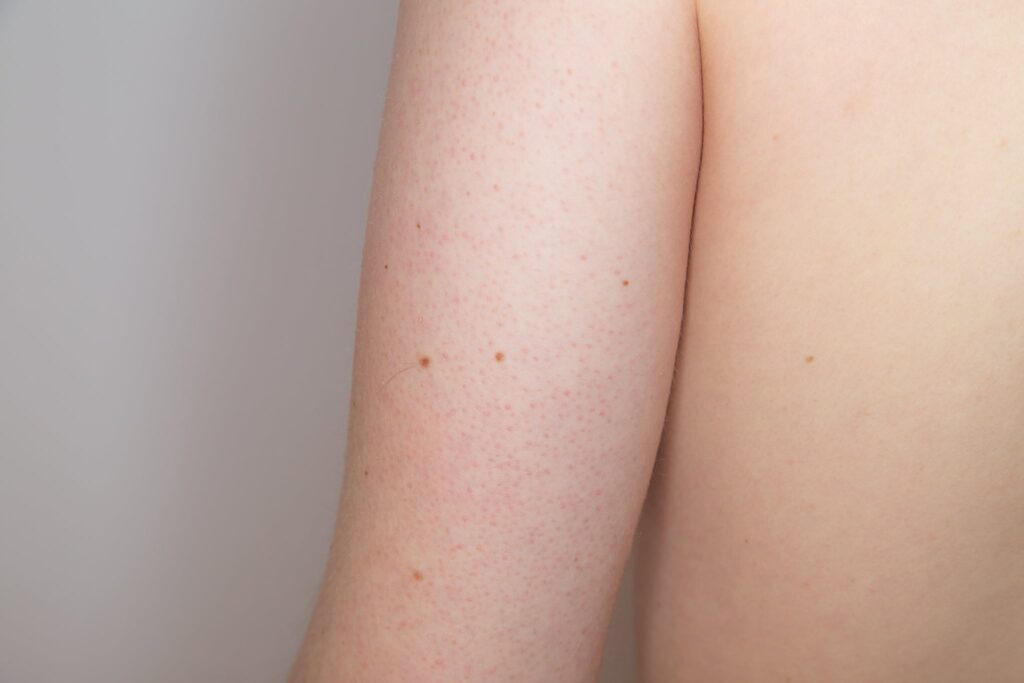If you’ve ever experienced small, rough bumps on your skin, particularly on your arms, thighs, or cheeks, then you may be familiar with a common condition called Keratosis Pilaris. This harmless, yet frustrating skin condition affects a large number of people, often causing self-consciousness and discomfort. However, there are strategies that can help manage this condition and achieve clearer, smoother skin. In this article, we will explore various approaches and techniques that can be incorporated into your skincare routine, helping you feel more confident and comfortable in your own skin.

Understanding Keratosis Pilaris
What is Keratosis Pilaris?
Keratosis Pilaris is a common skin condition that affects many people. It is characterized by the appearance of small, rough bumps on the skin, typically on the arms, legs, buttocks, and sometimes on the face. These bumps, often referred to as “chicken skin,” are caused by a buildup of keratin, a protein that protects the skin from infections and other harmful substances.
Causes of Keratosis Pilaris
The exact cause of Keratosis Pilaris is unknown, but it is believed to be a hereditary condition. If you have a family history of the condition, you are more likely to develop it yourself. Keratosis Pilaris is commonly associated with other skin conditions, such as eczema and dry skin, as well as certain allergic reactions. Hormonal changes, particularly during puberty, pregnancy, or menopause, can also trigger or worsen the condition.
Symptoms of Keratosis Pilaris
The primary symptom of Keratosis Pilaris is the appearance of small, rough bumps on the skin. These bumps are often skin-colored or slightly red and may feel rough to the touch. They can be itchy or have a slight burning sensation, but they are generally not painful. Some people may experience mild inflammation or redness around the bumps, especially if they scratch or pick at them. In most cases, Keratosis Pilaris does not cause any significant discomfort or health issues, but it can be a source of self-consciousness and embarrassment for some individuals.
Diagnosing Keratosis Pilaris
Consulting a Dermatologist
If you suspect that you have Keratosis Pilaris, it is recommended to consult a dermatologist for an accurate diagnosis. A dermatologist specializes in diagnosing and treating skin conditions and can provide valuable insights and guidance for managing Keratosis Pilaris.
Physical Examination
During the consultation, the dermatologist will perform a physical examination of your skin. They will closely examine the affected areas and look for the characteristic appearance of the small, rough bumps. They may also ask you about your symptoms, medical history, and family history of skin conditions.
Biopsy and other Tests
In some cases, a dermatologist may recommend a skin biopsy to confirm the diagnosis of Keratosis Pilaris. This involves taking a small sample of the affected skin for further analysis in a laboratory. Additionally, certain blood tests may be conducted to rule out any underlying medical conditions that could be contributing to the development of Keratosis Pilaris.

Popular Treatment Options
Topical Creams and Lotions
One of the most common treatment options for Keratosis Pilaris is the use of topical creams and lotions. These products often contain ingredients such as alpha hydroxy acids (AHAs), salicylic acid, urea, or lactic acid, which help to exfoliate and moisturize the skin. Regular application of these creams can help to reduce the roughness and improve the texture of the affected areas.
Oral Medications
In some cases, dermatologists may prescribe oral medications to help manage the symptoms of Keratosis Pilaris. These medications may include retinoids, which help to regulate the growth of skin cells, or antibiotics, which can reduce inflammation and prevent infection. It is important to note that these medications may have potential side effects, and they should only be taken under the supervision of a healthcare professional.
Chemical Peels
Chemical peels are another treatment option that can be effective in reducing the appearance of Keratosis Pilaris. During a chemical peel, a solution containing alpha hydroxy acids (AHAs) or other exfoliating agents is applied to the skin, causing it to peel and reveal smoother, healthier skin underneath. This procedure is usually performed in a dermatologist’s office and may require multiple sessions to achieve the desired results.
Natural Remedies and Home Treatments
Exfoliation and Moisturization
Regular exfoliation and moisturization can help to improve the appearance of Keratosis Pilaris. Gentle exfoliation with a scrub or brush can help to remove dead skin cells and unclog the hair follicles, reducing the buildup of keratin. After exfoliating, it is important to moisturize the skin to prevent dryness and further irritation. Look for moisturizers that contain ingredients like urea, lactic acid, or ceramides, which can help to hydrate and soften the skin.
Diet and Nutrition
While there is no specific diet that is proven to directly treat Keratosis Pilaris, maintaining a healthy and balanced diet can support overall skin health. Include foods rich in vitamins A, C, and E, as well as omega-3 fatty acids, which have anti-inflammatory properties. Drinking plenty of water can also help to keep the skin hydrated.
Home Remedies
There are several home remedies that people with Keratosis Pilaris have found to be helpful in managing their symptoms. These include applying coconut oil, apple cider vinegar, or aloe vera gel to the affected areas. However, it is important to note that these remedies may work differently for each individual and may not have scientific evidence to support their effectiveness.

Lifestyle Changes for Managing Keratosis Pilaris
Clothing and Fabrics
Wearing loose-fitting clothing made of breathable fabrics, such as cotton, can help to minimize friction and irritation on the skin. Avoid tight clothes or rough fabrics that can exacerbate the symptoms of Keratosis Pilaris.
Showering and Bathing Habits
When showering or bathing, avoid using hot water and harsh soaps that can strip the skin of its natural oils. Opt for lukewarm water and mild, fragrance-free cleansers that are gentle on the skin. Pat the skin dry instead of rubbing it vigorously, and immediately follow with a moisturizer to lock in the moisture.
Managing Stress
Stress can have a negative impact on the skin and may worsen the symptoms of Keratosis Pilaris. Find healthy ways to manage stress, such as practicing relaxation techniques, engaging in regular exercise, getting enough sleep, and seeking support from loved ones or professional counselors.
Managing Symptoms and Preventing Flare-Ups
Gentle Skin Care Routine
Establishing a gentle skin care routine is crucial for managing Keratosis Pilaris. Avoid scrubbing or picking at the bumps, as this can cause further irritation and potential scarring. Use mild cleansers and moisturizers that are specially formulated for sensitive or dry skin. Regular exfoliation with gentle products can help to prevent the buildup of keratin.
Avoiding Irritants
Certain substances and environmental factors can trigger or worsen the symptoms of Keratosis Pilaris. It is important to identify and avoid these irritants. This may include avoiding excessive sun exposure, swimming in chlorinated pools, or using harsh chemicals on the skin.
Protection from Sun Exposure
Sun exposure can exacerbate the symptoms of Keratosis Pilaris and cause further dryness and irritation. It is important to protect your skin from the sun by wearing protective clothing, using sunscreen with a high SPF, and seeking shade during peak sunlight hours.

Seeking Professional Help
Psychological Support
Dealing with a chronic skin condition like Keratosis Pilaris can take a toll on one’s emotional well-being. Seeking psychological support, such as therapy or counseling, can be beneficial for individuals struggling with self-esteem, body image, or anxieties related to their skin condition.
Support Groups and Online Communities
Joining support groups or participating in online communities can provide a sense of camaraderie and understanding among individuals with Keratosis Pilaris. Sharing experiences, tips, and advice with others who are going through similar challenges can be both comforting and empowering.
Alternative Therapies
In some cases, individuals may explore alternative therapies to manage the symptoms of Keratosis Pilaris. These may include acupuncture, herbal remedies, or homeopathic treatments. It is important to consult with a qualified healthcare professional before trying any alternative therapies to ensure their safety and effectiveness.
Coping with Emotional Impact
Understanding the Emotional Impact
Living with Keratosis Pilaris can have a significant emotional impact, especially if it affects visible areas of the body. It is important to acknowledge and understand the emotional challenges that may arise, such as feelings of self-consciousness, embarrassment, or frustration.
Building Self-Esteem and Confidence
Building self-esteem and confidence is essential in coping with the emotional impact of Keratosis Pilaris. Focus on your positive qualities and accomplishments, rather than solely on the appearance of your skin. Engage in activities that make you feel good about yourself, practice self-care, and surround yourself with supportive and uplifting people.
Seeking Professional Help
If the emotional impact of Keratosis Pilaris becomes overwhelming and starts to affect your daily life and well-being, it may be beneficial to seek professional help from a therapist or counselor. They can provide guidance and support in coping with the emotional challenges and help you develop healthy coping strategies.

When to Consult a Dermatologist
Severe Symptoms or Complications
If you experience severe symptoms of Keratosis Pilaris, such as intense itching, excessive redness, or inflammation, it is important to consult a dermatologist. They can assess the severity of your condition and recommend appropriate treatment options to manage your symptoms.
No Improvement with Home Treatments
If your symptoms of Keratosis Pilaris do not improve with home treatments or over-the-counter remedies, it is advisable to seek professional help. A dermatologist can evaluate your condition, adjust your treatment plan if necessary, and provide you with tailored recommendations.
Concerns about Appearance
If you have concerns about the appearance of your skin due to Keratosis Pilaris and it negatively impacts your self-esteem or quality of life, consulting a dermatologist can provide you with solutions and strategies to manage your concerns effectively.
Conclusion
While Keratosis Pilaris can be a frustrating and persistent skin condition, there are various treatment options, lifestyle changes, and coping strategies available to manage its symptoms and improve your quality of life. By understanding the condition, seeking professional help when needed, and taking care of your skin, you can successfully navigate the challenges posed by Keratosis Pilaris and achieve clearer and healthier skin. Remember, you are not alone in this journey, and with the right approach, you can confidently embrace your skin and feel comfortable in your own body.